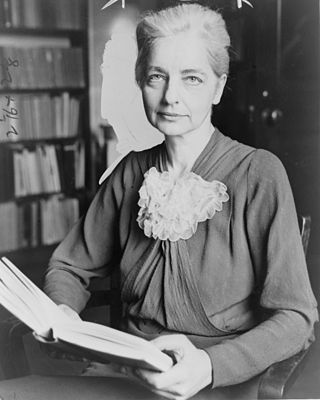
Margaret Mead was an American cultural anthropologist, author and speaker, who appeared frequently in the mass media during the 1960s and the 1970s.

Ruth Fulton Benedict was an American anthropologist and folklorist.

Trance and Dance in Bali is a short documentary film shot by the anthropologists Margaret Mead and Gregory Bateson during their research on Bali in the 1930s. It shows female dancers with sharp kris daggers dancing in trance, eventually stabbing themselves without injury. The film was not released until 1951. It has attracted praise from later anthropologists for its pioneering achievement, and criticism for its focus on the performance, omitting relevant details such as the conversation of the dancers.

Gregory Bateson was an English anthropologist, social scientist, linguist, visual anthropologist, semiotician, and cyberneticist whose work intersected that of many other fields. His writings include Steps to an Ecology of Mind (1972) and Mind and Nature (1979).

Mary Catherine Bateson was an American writer and cultural anthropologist.

Visual anthropology is a subfield of social anthropology that is concerned, in part, with the study and production of ethnographic photography, film and, since the mid-1990s, new media. More recently it has been used by historians of science and visual culture. Although sometimes wrongly conflated with ethnographic film, visual anthropology encompasses much more, including the anthropological study of all visual representations such as dance and other kinds of performance, museums and archiving, all visual arts, and the production and reception of mass media. Histories and analyses of representations from many cultures are part of visual anthropology: research topics include sandpaintings, tattoos, sculptures and reliefs, cave paintings, scrimshaw, jewelry, hieroglyphics, paintings and photographs. Also within the province of the subfield are studies of human vision, properties of media, the relationship of visual form and function, and applied, collaborative uses of visual representations.

Coming of Age in Samoa: A Psychological Study of Primitive Youth for Western Civilisation is a 1928 book by American anthropologist Margaret Mead based upon her research and study of youth – primarily adolescent girls – on the island of Taʻū in American Samoa. The book details the sexual life of teenagers in Samoan society in the early 20th century, and theorizes that culture has a leading influence on psychosexual development.

Steps to an Ecology of Mind is a collection of Gregory Bateson's short works over his long and varied career. Subject matter includes essays on anthropology, cybernetics, psychiatry, and epistemology. It was originally published by Ballantine Books in 1972.

Timothy Asch was an American anthropologist, photographer, and ethnographic filmmaker. Along with John Marshall and Robert Gardner, Asch played an important role in the development of visual anthropology. He is particularly known for his film The Ax Fight and his role with the USC Center for Visual Anthropology.
The Margaret Mead Film Festival is an annual film festival held at the American Museum of Natural History in New York City. It is the longest-running, premiere showcase for international documentaries in the United States, encompassing a broad spectrum of work, from indigenous community media to experimental nonfiction. The Festival is distinguished by its outstanding selection of titles, which tackle diverse and challenging subjects, representing a range of issues and perspectives, and by the forums for discussion with filmmakers and speakers.
Ray L. Birdwhistell was an American anthropologist who founded kinesics as a field of inquiry and research. Birdwhistell coined the term kinesics, meaning "facial expression, gestures, posture and gait, and visible arm and body movements". He estimated that "no more than 30 to 35 percent of the social meaning of a conversation or an interaction is carried by the words." Stated more broadly, he argued that "words are not the only containers of social knowledge." He proposed other technical terms, including kineme, and many others less frequently used today. Birdwhistell had at least as much impact on the study of language and social interaction generally as just nonverbal communication because he was interested in the study of communication more broadly than is often recognized. Birdwhistell understood body movements to be culturally patterned rather than universal. His students were required to read widely, sources not only in communication but also anthropology and linguistics. "Birdwhistell himself was deeply disappointed that his general communicative interests and goals were not appropriately understood." Collaborations with others, including initially Margaret Mead and Gregory Bateson, and later, Erving Goffman and Dell Hymes had huge influence on his work. For example, the book he is best known for, Kinesics and Context, "would not have appeared if it had not been envisaged by Erving Goffman" and he explicitly stated "the paramount and sustaining influence upon my work has been that of anthropological linguistics", a tradition most directly represented at the University of Pennsylvania by Hymes.

An ethnographic film is a non-fiction film, often similar to a documentary film, historically shot by Western filmmakers and dealing with non-Western people, and sometimes associated with anthropology. Definitions of the term are not definitive. Some academics claim it is more documentary, less anthropology, while others think it rests somewhere between the fields of anthropology and documentary films.

Reo Franklin Fortune was a New Zealand-born social anthropologist. Originally trained as a psychologist, Fortune was a student of some of the major theorists of British and American social anthropology including Alfred Cort Haddon, Bronislaw Malinowski and Alfred Radcliffe-Brown. He lived an international life, holding various academic and government positions: in China, at Lingnan University from 1937 to 1939; in Toledo, Ohio, USA from 1940 to 1941; at the University of Toronto, from 1941 to 1943; in Burma, as government anthropologist, from 1946 to 1947; and finally, at Cambridge University in the United Kingdom from 1947 to 1971, as lecturer in social anthropology specialising in Melanesian language and culture.

Final Cut for Real ApS is a film production company based in Copenhagen, Denmark specializing in documentaries for the international market. The two Oscar-nominated groundbreaking documentaries The Act of Killing (2012) and The Look of Silence (2014) helped establish the company as a recognized provider of independent creative documentaries on the international stage. The recent years, Final Cut for Real has also expanded to fiction films and virtual reality. In 2019 Final Cut for Real Norway was established.

Mark Atkin is a British filmmaker and director at Crossover Labs. He has directed and produced films, including co-producing The Big Melt and From the Sea to the Land Beyond, and organized film festival events.
Jerry Rothwell is a British documentary filmmaker best known for the award-winning feature docs How to Change the World (2015), Town of Runners (2012), Donor Unknown (2010), Heavy Load (2008) and Deep Water (2006). All of his films have been produced by Al Morrow of Met Film.

Almost There is a 2014 independent documentary film, produced by Kartemquin Films. It was directed by Aaron Wickenden and Dan Rybicky.
A Wife Among Wives is a 1981 ethnographic documentary produced by filmmakers Judith and David MacDougall. It is about the dynamics of polyamorous marriage in a small Turkana village in Kenya. The film premiered at the 1981 Margaret Mead Film Festival. It has a runtime of 72 minutes.
Hildred Storey Geertz was an American anthropologist who studied Balinese and Javanese kinship practices and Balinese art in Indonesia.
Jeffrey Waldron is an American cinematographer and director. Waldron worked on various feature films and TV series, including Little Fires Everywhere, Dear White People, Transpecos, You Hurt My Feelings, and Haunted Mansion. With Shannon Service he also co-directed Ghost Fleet, a 2018 award-winning documentary about immigrants tricked into forced labor on fishing ships in Thailand.












